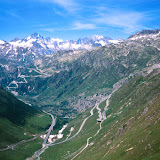Now that I have sample photos up, I can discuss
ND graduated filters, which are my favorite tool for serious landscape photography, so much so that I feel naked without them when I'm on a serious photography trip. As
described earlier, the fundamental problem of photography is to be able to render a scene that your eye can see into one that the digital sensor and your monitor (or print) can present.
Since slides and monitors can present about an 8:1 contrast ratio between the brightest and dimmest section of an image, while your eye (because it moves constantly and your brain composites all those images with no effort on your part) can see about 1000:1 contrast ratios in the same scene, you have a problem with a typical sunset or sunrise:
Note how the light (which your eye will render as yellow if you were there) is washed out, and the dark sections of the scene hold no shadow detail. (This is in addition to this film being shot by a point and shoot camera) The solution is to eliminate the dark portions of the scene through careful framing, and then placing an ND grad. filter right where the cloud-line would otherwise blow-out:
Now the light on the mountain looks closer to what you would see in reality if you were there. In the digital age, you can use
Photoshop and
Lightroom's
HDR facilities to achieve something similar through multiple exposures instead of carrying $100 filters, but if the clouds in the scene were moving at all, for instance, you can forget it! One reason I converted over to Lightroom from my beloved
Picasa is that you can apply an ND grad. filter after the fact in Lightroom (you
must shoot in RAW mode for this to work --- storage is so cheap nowadays there's no reason not to)! This is huge, since even if you habitually carry ND grad. filters, what this means is that you get effectively 2 more stops of additional filtration after the exposure if that's what you need.
When in doubt as to whether the scene requires the use of an ND grad. filter, what you can do is to switch the camera to spot meter mode, and quickly spot meter the brightest and darkest parts of the scene. If the difference between the two is more than about 2.5 stops, you need an ND grad. filter. To decide how much filtration you need, figure out the difference between the highlights and the shadows, and subtract 2.5 (or 2 stops if the arithmetic is hard) from it --- this is how many stops you need. I usually carry both a two stop and a three stop filter, and can combine the two to create a five stop scene. If you're shooting RAW digital, you can be off in this calculation by about two stops, since Lightroom will give you that much leeway. (If you're shooting slides, you better be exact, or spend more film and bracket)
A really important tip about placement of the line in the view-finder. It is essential that you stop down to shooting aperture before placing the filter! Where the line on the filter is changes depending on your shooting aperture, which is one reason why the SLR is a superior tool for serious landscape work than a TLR or a rangefinder camera. This is why even though you might be able to use a polarizer on a compact point and shoot, it will be difficult to use an ND grad. filter on one --- there's no way to see the shooting aperture.
Another place where ND. grad. filters are useful is in reflections:
Not all the light hitting the water bounces back in the direction of the camera --- some of it goes into the water as well, and as a result when you try to take a picture of a reflection, the reflection often looks too dark. The solution: an ND grad. filter with the gradation line placed right where the reflection is.
Graduated filters are not a panacea --- used wrong, they can look unnatural, and frequently there's not a good line you can use. But when faced with a high contrast scene (especially those wonderful alpenglow scenes that nature photographers love), they are indispensable, and well worth their weight in the camera bag.
(In a hurry you can drop the filter holder and adapter ring and just hold the filter in front of the lens) I also have a
full review of the Singh-Ray filters and why they're worth $100 each.













